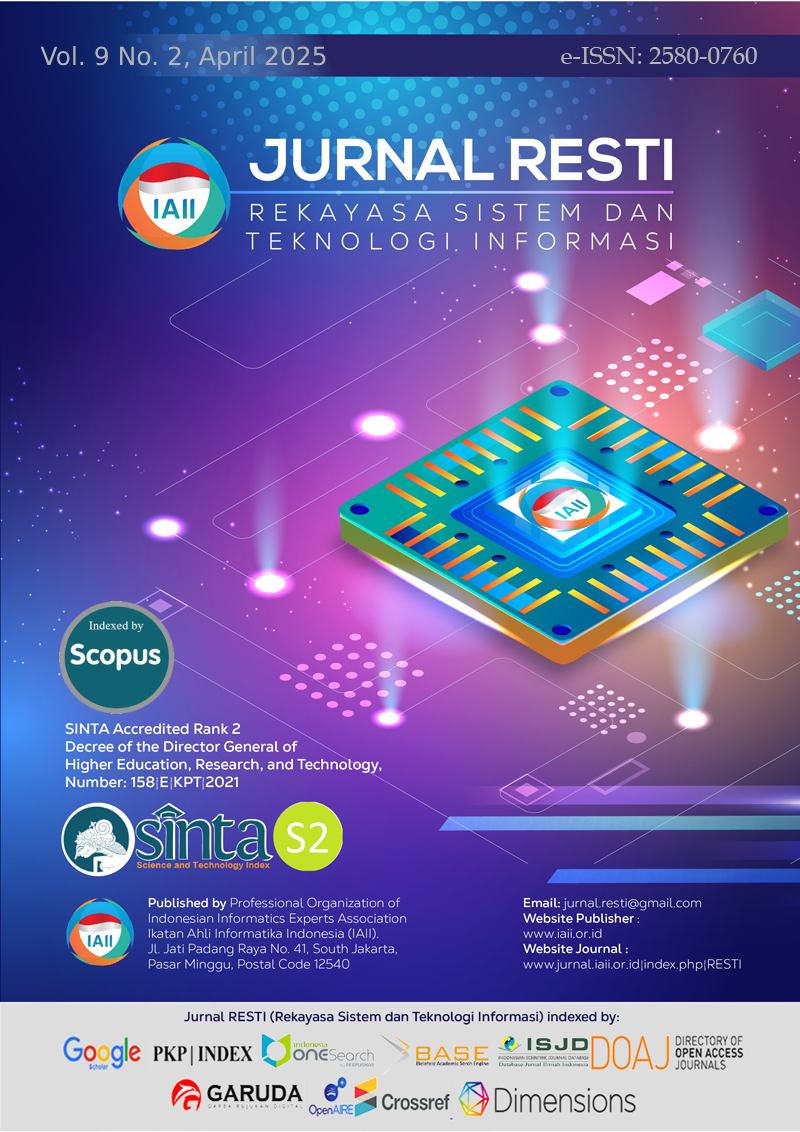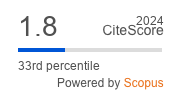Securing Electronic Medical Documents Using AES and LZMA
Abstract
With increasing threats in cyberspace, maintaining the integrity of electronic medical data is crucial. This study aims to develop a method that integrates encryption using Advanced Encryption Standard (AES) and compression with the Lempel-Ziv-Markov Algorithm (LZMA) to protect DICOM files containing sensitive information. This method is designed to address two main challenges: the growth of file sizes after the encryption process and the efficiency in data storage. In this study, an experimental design with random sampling was applied, testing 427 DICOM files from open libraries ranging in size from 513.06 KB to 513.39 KB to evaluate the implementation of this method in reducing file size, encryption time, and maintaining data integrity. The results show that this method is able to reduce file size by between 40-50% with an average encryption time of about 0.2-0.3 seconds per file. In addition, the data remains intact before and after the encryption process, which indicates that the integrity of the data is well maintained. Further analysis revealed that CPU usage during the encryption process reached 94.05%, while memory usage was recorded at 92.95 KB. In contrast, in the decryption process, CPU usage decreased to 78.16% with a much lower memory consumption, which was 31.07 KB. The findings have significant implications for medical information systems, allowing developers to easily implement these methods through APIs. This research is expected to be a reference for future studies that focus on data security in health information systems and provide new insights into the combination of encryption and compression in the context of medical data.
Downloads
References
A. Sarce Joel et al., “Tata Kelola Rekam Medis Berbasis Teknologi Informasi Dalam Penanganan Kerahasiaan Dan Keamanan Data Pasien Dengan Metode Kriptografi,” Jurnal Indonesia : Manajemen Informatika dan Komunikasi, vol. 4, no. 3, pp. 837–848, Sep. 2023, doi: 10.35870/JIMIK.V4I3.287.
H. S. Lallie et al., “Cyber security in the age of COVID-19: A timeline and analysis of cyber-crime and cyber-attacks during the pandemic,” Comput Secur, vol. 105, Jun. 2021, doi: 10.1016/j.cose.2021.102248.
B. Hartono, “Ransomware: Memahami Ancaman Keamanan Digital,” Bincang Sains dan Teknologi, vol. 2, no. 02, pp. 55–62, May 2023, doi: 10.56741/bst.v2i02.353.
H. Wijayanto, D. Daryono, and S. Nasiroh, “Analisis Forensik Pada Aplikasi Peduli Lindungi Terhadap Kebocoran Data Pribadi,” Jurnal Teknologi Informasi dan Komunikasi (TIKomSiN), vol. 9, no. 2, p. 11, Nov. 2021, doi: 10.30646/tikomsin.v9i2.572.
H. Rizki Kurnia, A. Zahrah, E. Ichsazene, and N. Aini Rakhmawati, “Analisis Bibliometrik Publikasi Isu Kebocoran Data Menggunakan VOSviewer,” Jurnal Informatika Sunan Kalijaga), vol. 8, no. 3, pp. 231–242, 2023, doi: https://doi.org/10.14421/jiska.2023.8.3.231-242.
I. Keshta and A. Odeh, “Security and privacy of electronic health records: Concerns and challenges,” Egyptian Informatics Journal, vol. 22, no. 2, pp. 177–183, Jul. 2021, doi: 10.1016/J.EIJ.2020.07.003.
O. G. Khoirunnisa and D. Djuniadi, “Implementasi Algoritma AES untuk Keamanan Data Rekam Medis,” PETIR, vol. 15, no. 1, pp. 21–27, Dec. 2021, doi: 10.33322/petir.v15i1.1333.
M. W. Malik, D. Husna, I. K. E. Purnama, I. Nurtanio, A. N. Hidayati, and A. A. P. Ratna, “Development of Medical Image Encryption System Using Byte-Level Base-64 Encoding and AES Encryption Method,” in ACM International Conference Proceeding Series, Association for Computing Machinery, Nov. 2020, pp. 153–158. doi: 10.1145/3442555.3442580.
R. Wahyudi and Moh. A. Romli, “Android-based Patient Medical Record Data Security Application using AES and RSA Method Cryptography,” Int J Comput Appl, vol. 185, no. 40, pp. 34–39, Nov. 2023, doi: 10.5120/ijca2023923205.
M. Azhari, J. Perwitosari, and F. Ali, “Implementasi Pengamanan Data pada Dokumen Menggunakan Algoritma Kriptografi Advanced Encryption Standard (AES),” Jurnal Pendidikan Sains dan Komputer, vol. 2, no. 1, pp. 2809–476, 2022, doi: 10.47709/jpsk.v2i1.1390.
A. K. Muthaura and J. Kandiri, “Data protection in Healthcare Information Systems Using Cryptographic Algorithm with Base64 512 bits,” Journal of the Kenya National Commission for UNESCO, vol. 4, no. 2, Jul. 2024, doi: 10.62049/jkncu.v4i2.105.
A. R et al., “Securing e-Health application of cloud computing using hyperchaotic image encryption framework,” Computers and Electrical Engineering, vol. 100, p. 107860, May 2022, doi: 10.1016/J.COMPELECENG.2022.107860.
K. A. Seputra, A. A. G. Y. Paramartha, G. A. Pradnyana, and K. Y. E. Aryanto, “A Middleware Applications Design for Health Information Sharing,” Jurnal RESTI (Rekayasa Sistem dan Teknologi Informasi), vol. 8, no. 3, pp. 321–332, Jun. 2024, doi: 10.29207/resti.v8i3.5707.
Resdiansyah, J. Darmawan, A. H. Wijaya, L. Hakim, and H. Tannady, “Comparing Freeman Chain Code 4 Adjacency Algorithm and LZMA Algorithm in Binary Image Compression,” in Journal of Physics: Conference Series, IOP Publishing Ltd, Feb. 2021. doi: 10.1088/1742-6596/1783/1/012045.
S. A. Nooh, “Cloud Cryptography: User End Encryption,” 2020 International Conference on Computing and Information Technology, ICCIT 2020, Sep. 2020, doi: 10.1109/ICCIT-144147971.2020.9213745.
R. Sowmyalakshmi et al., “An Optimal Lempel Ziv Markov Based Microarray Image Compression Algorithm,” Computers, Materials and Continua, vol. 69, no. 2, pp. 2245–2260, 2021, doi: 10.32604/CMC.2021.018636.
Z. Mishra and B. Acharya, “High throughput and low area architectures of secure IoT algorithm for medical image encryption,” Journal of Information Security and Applications, vol. 53, Aug. 2020, doi: 10.1016/J.JISA.2020.102533.
M. Hasyim Ratsanjani, I. Fitria Risnandari, T. Widya Sulaiman, and V. Meida Hersianty, “Literatur Review: Peran Aplikasi SAAS Dalam Kegiatan Bisnis E-Commerce,” SINOMIKA Journal: Publikasi Ilmiah Bidang Ekonomi dan Akuntansi, vol. 1, no. 4, pp. 1009–1020, Nov. 2022, doi: 10.54443/sinomika.v1i4.491.
R. Rojas-Hernández, J. L. Díaz-De-león-santiago, G. Barceló-Alonso, J. Bautista-López, V. Trujillo-Mora, and J. C. Salgado-Ramírez, “Lossless Medical Image Compression by Using Difference Transform,” Entropy, vol. 24, no. 7, Jul. 2022, doi: 10.3390/E24070951.
A. R. Ekaputra and A. S. Affandi, “Pemanfaatan layanan cloud computing dan docker container untuk meningkatkan kinerja aplikasi web,” Journal of Information System and Application Development, vol. 1, no. 2, pp. 138–147, Sep. 2023, doi: 10.26905/jisad.v1i2.11084.
J. T. Informasi, A. Ridho, and C. R. Niani, “Implementasi Enkripsi Dengan Vigenere Cipher Dan Reverse Cipher Menggunakan Bahasa Pemrograman Python,” Jurnal Teknologi Informasi, vol. 1, no. 1, pp. 9–15, May 2022, doi: https://doi.org/10.35308/.v1i1.5486.
Z. Chen and G. Ye, “An asymmetric image encryption scheme based on hash SHA-3, RSA and compressive sensing,” Optik (Stuttg), vol. 267, p. 169676, Oct. 2022, doi: 10.1016/J.IJLEO.2022.169676.
Resdiansyah, J. Darmawan, A. H. Wijaya, L. Hakim, and H. Tannady, “Comparing Freeman Chain Code 4 Adjacency Algorithm and LZMA Algorithm in Binary Image Compression,” in Journal of Physics: Conference Series, IOP Publishing Ltd, Feb. 2021. doi: 10.1088/1742-6596/1783/1/012045.
E. Öztürk and A. Mesut, “Learning-based short text compression using BERT models,” PeerJ Comput Sci, vol. 10, 2024, doi: 10.7717/peerj-cs.2423.
A. Hafsa, A. Sghaier, J. Malek, and M. Machhout, “Image encryption method based on improved ECC and modified AES algorithm,” Multimed Tools Appl, vol. 80, no. 13, pp. 19769–19801, May 2021, doi: 10.1007/S11042-021-10700-X.
D. A. Clunie, “DICOM Format and Protocol Standardization—A Core Requirement for Digital Pathology Success,” Toxicol Pathol, vol. 49, no. 4, pp. 738–749, Jun. 2021, doi: 10.1177/0192623320965893.
K. Masters, “Ethical use of Artificial Intelligence in Health Professions Education: AMEE Guide No. 158,” Med Teach, vol. 45, no. 6, pp. 574–584, 2023, doi: 10.1080/0142159X.2023.2186203.
R. O. Bura and H. S. Nida, “Image Transmission Using Base64 Encoding and Advanced Encryption Standard Algorithm Based on Socket Programming,” Proceedings - IWBIS 2021: 6th International Workshop on Big Data and Information Security, pp. 115–120, 2021, doi: 10.1109/IWBIS53353.2021.9631846.
A. Meylan, M. Cherubini, B. Chapuis, M. Humbert, I. Bilogrevic, and K. Huguenin, “A Study on the Use of Checksums for Integrity Verification of Web Downloads,” ACM Transactions on Privacy and Security, vol. 24, no. 1, Nov. 2020, doi: 10.1145/3410154.
D. Prasetyo, A. Utami, and T. G. Laksana, “Website Based Academic Information System Design Using Extreme Programming Method,” Journal of Informatics Information System Software Engineering and Applications (INISTA), vol. 6, no. 2, pp. 134–143, Jul. 2024, doi: 10.20895/inista.v6i2.1214.
R. Salwa, M. Irwan, P. Nasution, F. Ekonomi, and D. Bisnis, “Teknik Pelestarian Privasi Data Di Database Cloud,” Kohesi: Jurnal Sains Dan Teknologi, vol. 3(7), pp. 11–20, 2024, doi: https://doi.org/10.3785/kohesi.v3i7.3735.
Copyright (c) 2025 Jurnal RESTI (Rekayasa Sistem dan Teknologi Informasi)

This work is licensed under a Creative Commons Attribution 4.0 International License.
Copyright in each article belongs to the author
- The author acknowledges that the RESTI Journal (System Engineering and Information Technology) is the first publisher to publish with a license Creative Commons Attribution 4.0 International License.
- Authors can enter writing separately, arrange the non-exclusive distribution of manuscripts that have been published in this journal into other versions (eg sent to the author's institutional repository, publication in a book, etc.), by acknowledging that the manuscript has been published for the first time in the RESTI (Rekayasa Sistem dan Teknologi Informasi) journal ;








